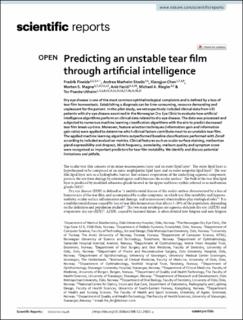| dc.contributor.author | Fineide, Fredrik | |
| dc.contributor.author | Storås, Andrea | |
| dc.contributor.author | Chen, Xiangjun | |
| dc.contributor.author | Magnø, Morten Schjerven | |
| dc.contributor.author | Yazidi, Anis | |
| dc.contributor.author | Riegler, Michael | |
| dc.contributor.author | Utheim, Tor Paaske | |
| dc.date.accessioned | 2022-12-19T09:36:45Z | |
| dc.date.available | 2022-12-19T09:36:45Z | |
| dc.date.created | 2022-12-13T11:19:58Z | |
| dc.date.issued | 2022 | |
| dc.identifier.issn | 2045-2322 | |
| dc.identifier.uri | https://hdl.handle.net/11250/3038424 | |
| dc.description.abstract | Dry eye disease is one of the most common ophthalmological complaints and is defined by a loss of tear film homeostasis. Establishing a diagnosis can be time-consuming, resource demanding and unpleasant for the patient. In this pilot study, we retrospectively included clinical data from 431 patients with dry eye disease examined in the Norwegian Dry Eye Clinic to evaluate how artificial intelligence algorithms perform on clinical data related to dry eye disease. The data was processed and subjected to numerous machine learning classification algorithms with the aim to predict decreased tear film break-up time. Moreover, feature selection techniques (information gain and information gain ratio) were applied to determine which clinical factors contribute most to an unstable tear film. The applied machine learning algorithms outperformed baseline classifications performed with ZeroR according to included evaluation metrics. Clinical features such as ocular surface staining, meibomian gland expressibility and dropout, blink frequency, osmolarity, meibum quality and symptom score were recognized as important predictors for tear film instability. We identify and discuss potential limitations and pitfalls. | en_US |
| dc.language.iso | eng | en_US |
| dc.publisher | Springer Nature | en_US |
| dc.rights | Navngivelse 4.0 Internasjonal | * |
| dc.rights.uri | http://creativecommons.org/licenses/by/4.0/deed.no | * |
| dc.title | Predicting an unstable tear film through artificial intelligence | en_US |
| dc.title.alternative | Predicting an unstable tear film through artificial intelligence | en_US |
| dc.type | Peer reviewed | en_US |
| dc.type | Journal article | en_US |
| dc.description.version | publishedVersion | en_US |
| dc.source.volume | 12 | en_US |
| dc.source.journal | Scientific Reports | en_US |
| dc.source.issue | 1 | en_US |
| dc.identifier.doi | 10.1038/s41598-022-25821-y | |
| dc.identifier.cristin | 2092452 | |
| cristin.ispublished | true | |
| cristin.fulltext | original | |
| cristin.qualitycode | 1 | |

